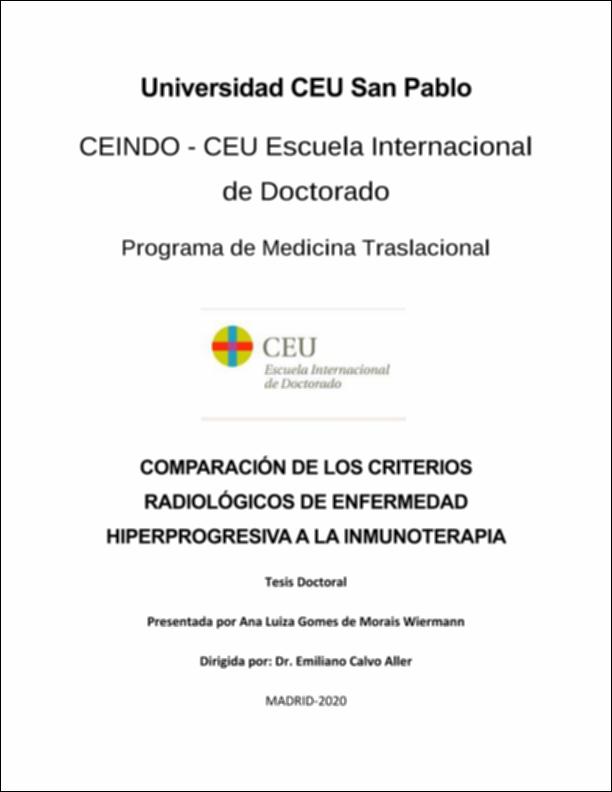Please use this identifier to cite or link to this item:
http://hdl.handle.net/10637/12279Comparación de los criterios radiológicos de enfermedad hiperprogresiva a la inmunoterapia.
| Title: | Comparación de los criterios radiológicos de enfermedad hiperprogresiva a la inmunoterapia. |
| Authors : | Gomes de Morais Wiermann, Ana Luiza |
| Keywords: | Oncología - Tesis doctorales.; Tumor; Inmunoterapia; Inhibidores del punto de control inmunitario; Inmunotherapy; Immune checkpoint inhibitors |
| Abstract: | La enfermedad hiperprogresiva (HPD) es una preocupante aceleración paradójica del
crecimiento del tumor inducida por las inmunoterapias. La falta de criterios radiológicos
estándar hace que su estudio sea particularmente difícil. Revisamos la literatura y
comparamos los principales criterios para la HPD propuestos por Ferté, Le Tourneau,
Garralda y Caramella para abordar este relevante fenómeno de la Inmuno Oncología. De
los 182 pacientes consecutivos con cáncer avanzado tratados con inmunoterapia en
ensayos clínicos de fase temprana, 71 con enfermedad progresiva en la primera
evaluación fueron elegibles. Se estudiaron los pacientes de HPD en relación con la
dinámica de crecimiento del tumor y el impacto clínico. Se produjo HPD en 17 (23,9%),
17 (23,9%), 23 (32,4%) y 6 (8,4%) pacientes, según la definición de Ferté, Le Tourneau,
Garralda y Caramella, respectivamente. La asociación más fuerte se encontró entre los
criterios de Ferté y Le Tourneau (Kappa = 0,61), y el índice de similitud de Jaccard varió
entre el 55% (Ferté y Le Tourneau) y el 21% (Le Tourneau y Caramella). Los criterios de
Ferté y Le Tourneau mostraron diferencias estadísticamente significativas entre las tasas
de crecimiento del tumor antes y después de la evaluación basal en pacientes con HPD,
que no pudieron ser confirmadas con los criterios de Caramella y Garralda. Se
observaron diferencias significativas en la supervivencia libre de progresión entre los no
hiperprogresores y los hiperprogresores, al largo de todos los criterios. La proporción de
pacientes que no pudieron recibir líneas de tratamiento adicionales fue mayor en el grupo
con HPD. El HPD es una aceleración de la cinética de crecimiento del tumor relacionada
con la inmunoterapia, con un consiguiente impacto clínico negativo. Para identificar el
HPD se requieren tomografías computarizadas previas a la línea de base y evaluaciones
de la tasa de crecimiento del tumor. Nuestro análisis favorece el uso del método de Le
Tourneau, ya que captura adecuadamente el fenómeno del HPD y es más conveniente
de usar. Hyperprogressive disease (HPD) is a concerning paradoxical acceleration of cancer growth induced by immune drugs. The lack of standard radiological criteria makes its study challenging. We reviewed the literature and compared the main criteria for HPD proposed by Ferté, Le Tourneau, Garralda and Caramella to address this relevant unmet need in Immune Oncology. Among 182 consecutive patients with advanced cancer treated with immunotherapy in early-phase clinical trials, 71 with progressive disease at the first evaluation were eligible. HPD patients were studied regarding tumor growth dynamics and clinical impact. HPD occurred in 17 (23.9%), 17 (23.9%), 23 (32.4%) and 6 (8.4%) patients, as defined by Ferté, Le Tourneau, Garralda and Caramella, respectively. The strongest association was found between the Ferté and Le Tourneau criteria (Kappa = 0.61), and the Jaccard similarity index varied from 55% (Ferté and Le Tourneau) to 21% (Le Tourneau and Caramella). The Ferté and Le Tourneau criteria showed statistically significant differences between pre-baseline and post-baseline tumor growth rate in patients with HPD, which could not be confirmed with the Caramella and Garralda criteria. Significant differences in progression-free survival were observed between non-hyperprogressors and hyperprogressors, with all criteria. The proportion of patients that could not receive additional lines of therapy was higher in the HPD group. HPD is an immunotherapy-related acceleration of tumor growth kinetics, with a consequent negative clinical impact. Pre-baseline CT scans and tumor growth rate evaluations are required to identify HPD. Our analysis favors the use of the Le Tourneau method, as it captures adequately the HPD phenomenon and is more convenient to use. |
| Description: | Tesis-CEINDO, Universidad San Pablo CEU, Programa en Medicina Traslacional, leida 24 de marzo de 2021. |
| Director(s): | Calvo Aller, Emiliano |
| URI: | http://hdl.handle.net/10637/12279 |
| Rights : | http://creativecommons.org/licenses/by-nc-nd/4.0/deed.es |
| Issue Date: | 7-Apr-2021 |
| Center : | Universidad San Pablo-CEU |
| Appears in Collections: | Medicina Traslacional |
Items in DSpace are protected by copyright, with all rights reserved, unless otherwise indicated.


